
Beaumont is a lava-flooded crater located on the southwestern shore of the Mare Nectaris on Earth's Moon. It lies to the northwest of the similarly flooded crater remnant Fracastorius. To the west is the prominent crater Catharina. The crater is named after French geologist Léonce Élie de Beaumont.
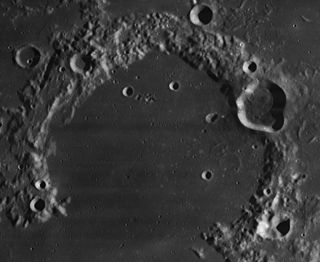
Russell is the lava-flooded remains of a lunar impact crater. It is located in the western part of the Oceanus Procellarum, close to the western lunar limb. As a result, it appears oblong-shaped due to foreshortening.
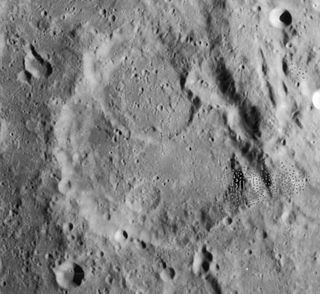
Catharina is an ancient lunar impact crater located in the southern highlands. It was named after Saint Catherine of Alexandria. It lies in a rugged stretch of land between the Rupes Altai scarp to the west and Mare Nectaris in the east. To the west-northwest is the crater Tacitus, and the lava-flooded Beaumont lies to the east along the shore of Mare Nectaris. To the south-southeast is Polybius.
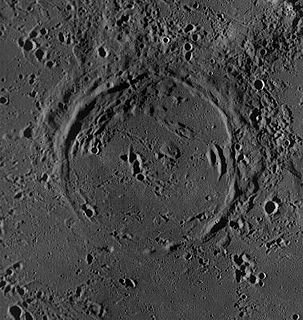
Daguerre is a circular formation near the north end of Mare Nectaris. To the west-northwest is the crater Mädler, and beyond it to the west is the prominent Theophilus. To the north in the rugged continental area between the maria is Isidorus.

Egede is the remains of a lunar impact crater that has been flooded by lava, leaving only the somewhat polygonal circumference of the rim protruding just above the mare. It was named after Dano-Norwegian natural historian Hans Egede. It is located on the southern edge of the Mare Frigoris, to the west of the crater Aristoteles. To the southwest is an arc of low mountains curving between the rims of Aristoteles and Eudoxus. The floor of Egede is flat and nearly featureless, except for a few tiny craterlets, including secondaries from Aristoteles. The surviving rim has a maximum altitude of 0.4 km above the surface.
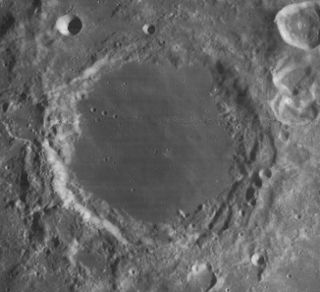
Endymion is a lunar impact crater that lies near the northeast limb of the Moon. It is located to the east of Mare Frigoris, and north of the Lacus Temporis. To the southwest is the somewhat smaller crater Atlas. Because of its location, Endymion has an oval appearance from foreshortening. Beyond the crater along the lunar limb is the Mare Humboldtianum.
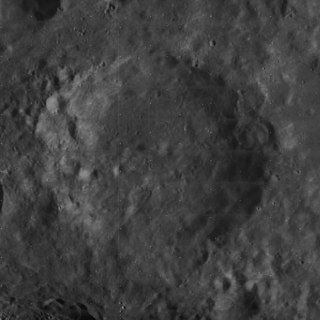
Snellius is a lunar impact crater located near the southeast limb of the Moon.

Bohnenberger is a lunar impact crater that lies near the east edge of the Mare Nectaris, in the foothills of the Montes Pyrenaeus mountain range that forms the perimeter of the mare. To the east beyond the mountains is the larger crater Colombo. The crater has a low rim along the north wall, and the floor is somewhat irregular with a ridge crossing the floor. There is a small crater along the western inner wall.

Bonpland is the remains of a lunar impact crater that is attached to the walled plain Fra Mauro to the north and Parry to the east. The intersection of their rims forms a three-pointed mountainous rise. To the southeast is the small crater Tolansky. Bonpland lies on the eastern edge of Mare Cognitum. It is named after Aimé Bonpland, a French explorer and botanist.

Capella is a lunar impact crater 49 km (30 mi) in diameter that lies to the north of the Mare Nectaris, in a rugged region with many small impact craters. It was named after Roman astronomer Martianus Capella. It intrudes slightly into the eastern rim of the crater Isidorus, a feature only slightly smaller in diameter.
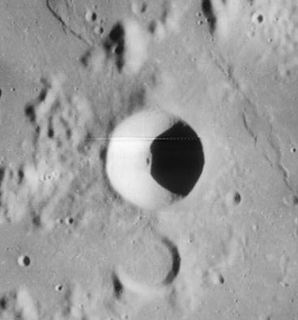
Darney is a small lunar impact crater that is located on the region of the Moon where the Mare Nubium joins the Oceanus Procellarum. It was named after French astronomer Maurice Darney. To the south is the lava-flooded crater Lubiniezky. The southern rim of Darney is attached to a series of low ridges that extend to the southwest.
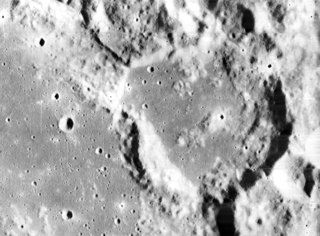
Condon is a lunar impact crater that lies on the eastern shore of the Sinus Successus, a bay along the northeast edge of Mare Fecunditatis. It was named after American physicist Edward U. Condon. It lies midway between the larger crater Apollonius to the north and the smaller Webb to the south on the Mare Fecunditatis. Condon was previously designated Webb R.

Cusanus is a lunar impact crater that is located near the northeastern limb of the Moon. In this location the crater appears very foreshortened when observed from the Earth, and its visibility is affected by libration. The northern rim of Cusanus is nearly joined to the south-southeastern rim of the larger crater Petermann. To the west is Baillaud and to the southeast is Hayn.

Isidorus is a lunar impact crater that is located to the north of the Mare Nectaris, on the eastern half of the Moon's near side. It was named after Spanish astronomer Saint Isidore of Seville. It forms a pair with the slightly larger Capella, which is attached to the east-northeastern rim. To the west-southwest across the lunar mare are Mädler and the prominent Theophilus.

Loewy is a small lunar impact crater that lies along the eastern rim of Mare Humorum, in the southwest part of the Moon's near side. It was named after French astronomer Maurice Loewy. This is a lava-flooded formation that lies to the southwest of the larger, lava-flooded crater Agatharchides. To the southeast is an even larger lava-flooded formation, Hippalus.

Crozier is a lunar impact crater that is located on the southwest edge of Mare Fecunditatis, a lunar mare in the eastern part of the Moon's near side. It lies to the east-northeast of the prominent crater Colombo, and southeast of the small crater Bellot.

Chrétien is a lunar impact crater that is located in the southern hemisphere on the far side of the Moon from the Earth. It lies due south of the Mare Ingenii, one of the few maria on the Moon's far side. The crater lies in the midpoint between the craters Garavito to the west-southwest and Oresme to the east-northeast, both of these being somewhat smaller than Chrétien.

Lorentz is a huge lunar impact crater that lies just beyond the northwest limb of the Moon, in a region that is brought into sight of the Earth during favorable librations. This formation is nearly as large as the Mare Nectaris on the near side of the Moon, although it has not been submerged by lava as have the lunar mare. Sections of the crater floor are, however, relatively level, particularly an arc along the western rim. But this last region is still marked by a number of tiny craterlets. The remainder of the interior is rough and irregular, and marked with a multitude of impacts.

Chevallier is a lunar impact crater that is located in the northeastern part of the Moon's near side, about a crater diameter east-southeast of the prominent crater Atlas. To the south-southeast of Chevallier is the flooded crater Shuckburgh.

Neujmin is a lunar impact crater on the Moon's far side. It is nearly attached to the west-southwest of the smaller crater Waterman, and lies to the southwest of the prominent Tsiolkovskiy.
























